Scientists at the National University of Singapore (NUS) have invented a unique hydrogel that effectively dehumidifies ambient air to improve thermal comfort. The hydrogel harnesses the moisture in the air for a wide range of practical applications, such as functioning as a sun or privacy screen, conductive ink and even a battery.
A hydrogel is a form of zinc oxide in a gel-like state. It absorbs water from the surrounding environment more than 2.5 times its weight and performs at least eight times better than commercial drying agents.
Assistant Professor Tan Swee Ching from the Department of Materials Science and Engineering at the NUS Faculty of Engineering, who led the research said, “This novel hydrogel performs at least eight times better than existing drying agents, such as silica gel and calcium chloride, in removing moisture from the air – it can absorb more water, works faster and uses less material.”
“Unlike energy-intensive dehumidifying and air-conditioning systems, this hydrogel does not require electricity to operate. It can be easily coated onto walls, windows and even decorative items (such as a sculpture) to perform the dehumidifying function. Moreover, It is suitable for both indoor and outdoor applications, and is also cheap and easy to produce.”
The potential advantage of the hydrogel includes that it reduces the relative humidity in a confined space from 80 percent to 60 percent – within the thermal comfort zone – in less than seven minutes. It also holds the potential for reducing the relative humidity in both indoor and outdoor environments, such as in hospital wards and classrooms without air conditioning, as well as in parks and bus stops.
After taking in water from the environment, the novel hydrogel becomes opaque and reduces infrared transmission by about 50 percent. This translates into a reduction in ambient temperature by more than seven degrees Celsius. Hence, the hydrogel can be used as a smart window material to block off the heat from natural sunlight while doubling up as a privacy screen.
Asst Prof Tan explained, “Moisture in the air is an abundant resource, but there are few attempts to harvest and put it to good use. When our novel hydrogel absorbs water, we observed that it displays interesting optical, electrical and electrochemical properties. This opens up a wide range of useful applications.”
This material is reasonable for diminishing relative humidity in both indoor and outdoor situations, for example, in healing facility wards and classrooms without aerating and cooling, and in addition in parks and transport stops.
When used together with air conditioners, building or homeowners could enjoy savings in energy cost as the cooler ambient air will require less electricity to chill it to the desired temperature.
The research team also discovered that the hydrogel can generate about 1.8 volts of electricity – similar to the AA battery. This potential leads the material to be use din electronics to power up the devices. The research team also discovered that the hydrogel can generate about 1.8 volts of electricity – similar to the AA battery.
These research findings have been published online in the scientific journal Energy & Environmental Science on 24 May 2018.
